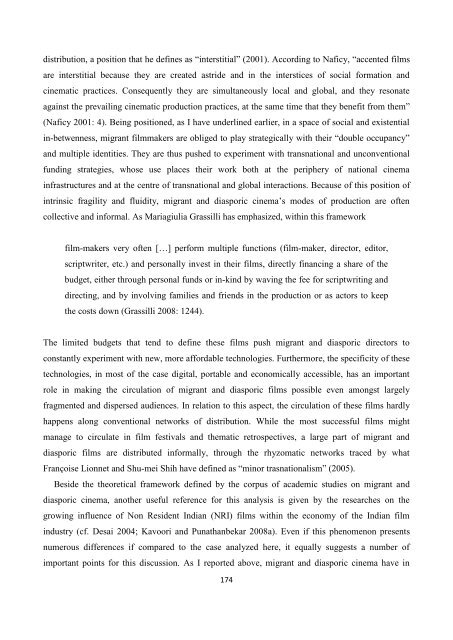Create successful ePaper yourself
Turn your PDF publications into a flip-book with our unique Google optimized e-Paper software.
distribution, a position that he defines as “interstitial” (2001). According to Naficy, “accented filmsare interstitial because they are created astride and in the interstices of social formation andcinematic practices. Consequently they are simultaneously local and global, and they resonateagainst the prevailing cinematic production practices, at the same time that they benefit from them”(Naficy 2001: 4). Being positioned, as I have underlined earlier, in a space of social and existentialin-betwenness, migrant filmmakers are obliged to play strategically with their “double occupancy”and multiple identities. They are thus pushed to experiment with transnational and unconventionalfunding strategies, whose use places their work both at the periphery of national cinemainfrastructures and at the centre of transnational and global interactions. Because of this position ofintrinsic fragility and fluidity, migrant and diasporic cinema’s modes of production are oftencollective and informal. As Mariagiulia Grassilli has emphasized, within this frameworkfilm-makers very often […] perform multiple functions (film-maker, director, editor,scriptwriter, etc.) and personally invest in their films, directly financing a share of thebudget, either through personal funds or in-kind by waving the fee for scriptwriting anddirecting, and by involving families and friends in the production or as actors to keepthe costs down (Grassilli 2008: 1244).The limited budgets that tend to define these films push migrant and diasporic directors toconstantly experiment with new, more affordable technologies. Furthermore, the specificity of thesetechnologies, in most of the case digital, portable and economically accessible, has an importantrole in making the circulation of migrant and diasporic films possible even amongst largelyfragmented and dispersed audiences. In relation to this aspect, the circulation of these films hardlyhappens along conventional networks of distribution. While the most successful films mightmanage to circulate in film festivals and thematic retrospectives, a large part of migrant anddiasporic films are distributed informally, through the rhyzomatic networks traced by whatFrançoise Lionnet and Shu-mei Shih have defined as “minor trasnationalism” (2005).Beside the theoretical framework defined by the corpus of academic studies on migrant anddiasporic cinema, another useful reference for this analysis is given by the researches on thegrowing influence of Non Resident Indian (NRI) films within the economy of the Indian filmindustry (cf. Desai 2004; Kavoori and Punathanbekar 2008a). Even if this phenomenon presentsnumerous differences if compared to the case analyzed here, it equally suggests a number ofimportant points for this discussion. As I reported above, migrant and diasporic cinema have in174
















